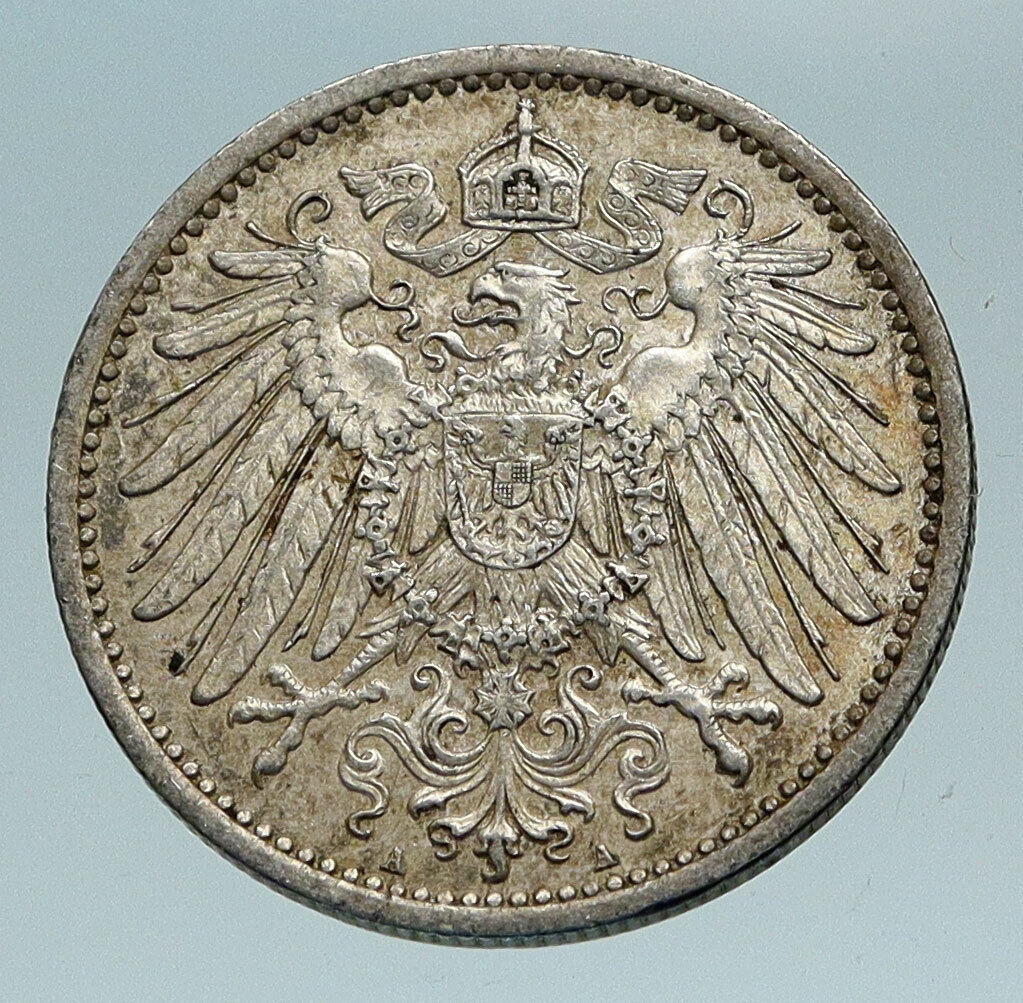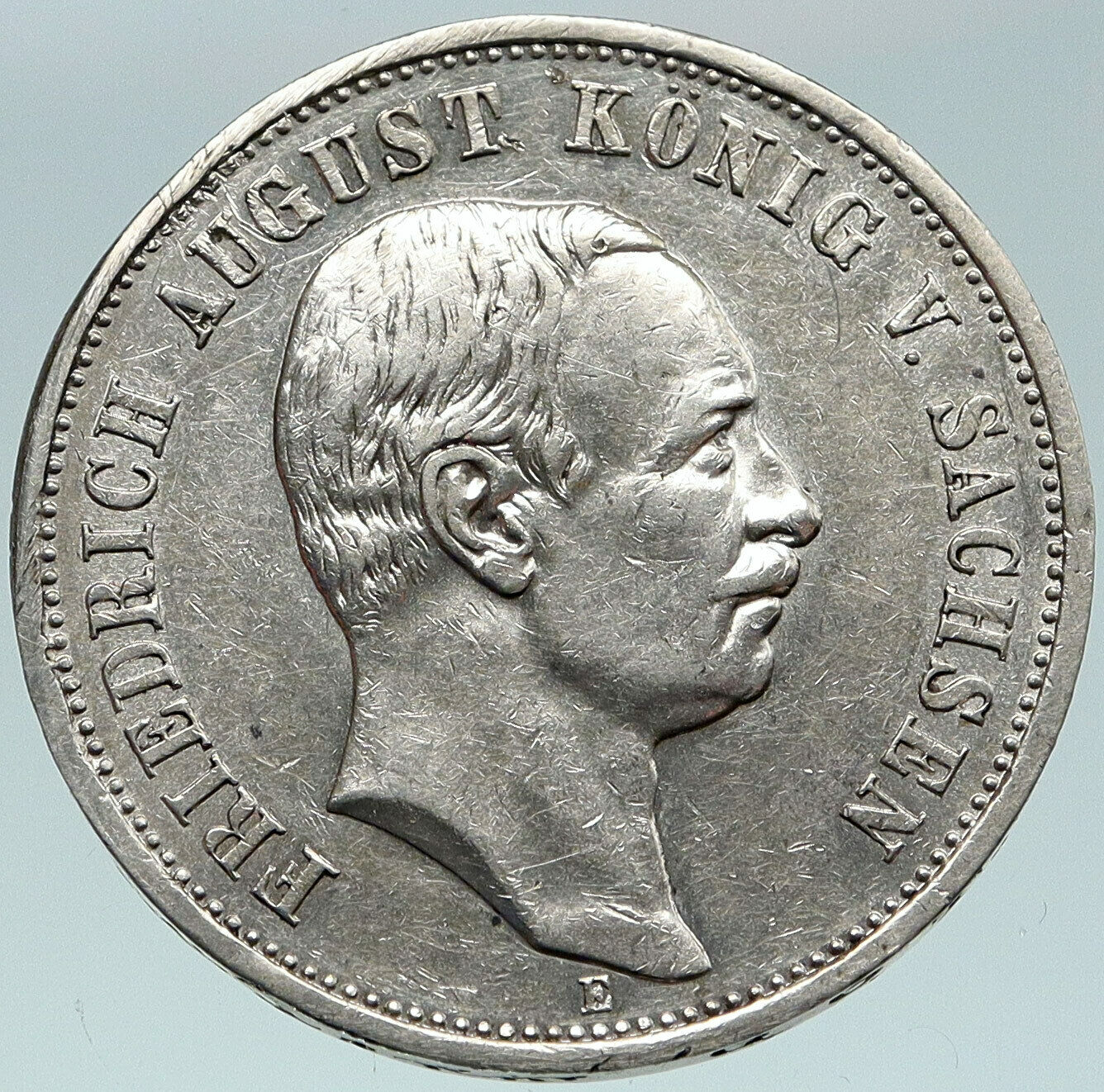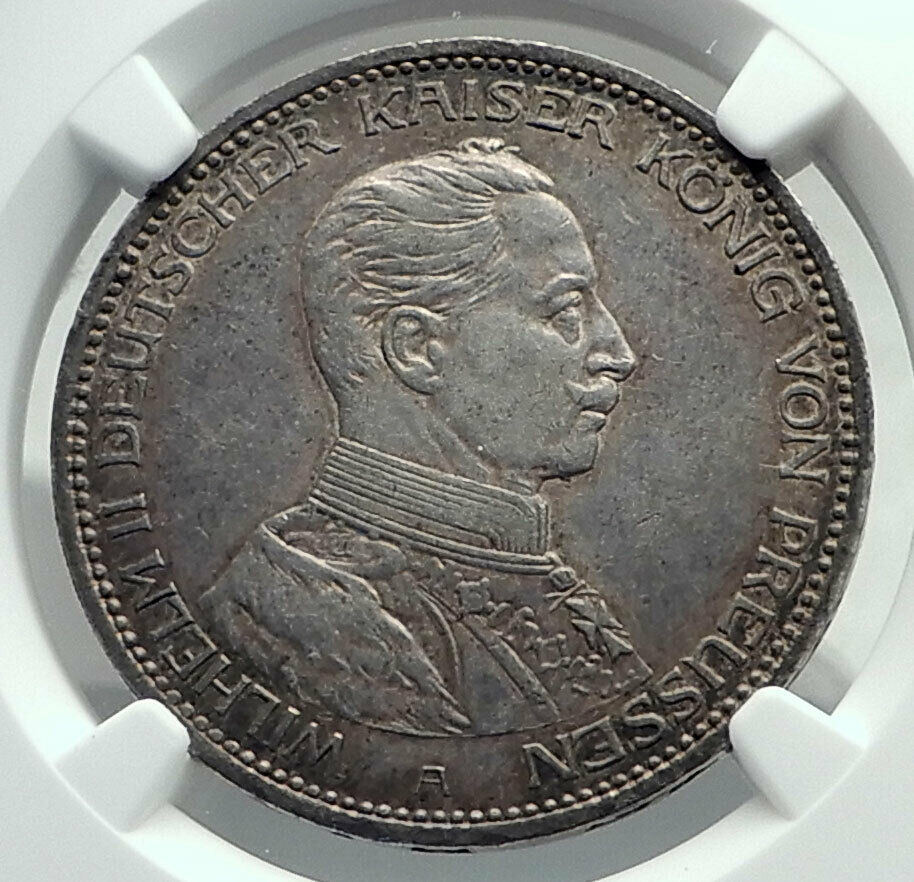|
Germany – German States. Kingdom of Hessen-Darmstadt
400th Birthday of Philipp the Magnanimous
1904 Silver 2 Mark 28mm (11.00 grams) .900 Silver 0.3215 oz. ASW)
Reference: KM# 372, J# 74
PHILIPP LANDGRAF Z.HESSEN ERNST LUDWIG GROSSHERZOG V.HESSEN U.B.R. VERBUM.DNI.MANET.IN.AETERNUM 13 NOV.1504-1904, Phillpp Count of Hessen and Ernst Ludwig Great Duke of Hessen and at Rhine facing left.
DEUTSCHES REICH 1904 * ZWEI MARK * , Crowned eagle.
You are bidding on the exact item pictured, provided with a Certificate of Authenticity and Lifetime Guarantee of Authenticity.
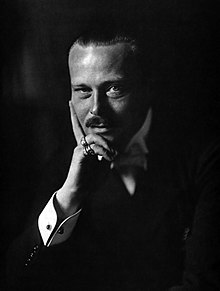 Ernest Louis (German: Ernst Ludwig Karl Albrecht Wilhelm; 25 November 1868 – 9 October 1937) was the last Grand Duke of Hesse and by Rhine, reigning from 1892 until 1918. Ernest Louis (German: Ernst Ludwig Karl Albrecht Wilhelm; 25 November 1868 – 9 October 1937) was the last Grand Duke of Hesse and by Rhine, reigning from 1892 until 1918.
On 19 April 1894, at Schloss Ehrenburg, Ernest Louis married his maternal first cousin, Princess Victoria Melita of Saxe-Coburg and Gotha (“Ducky”), the daughter of his mother’s brother, Prince Alfred. The match was actively encouraged by their mutual grandmother, Queen Victoria, who attended the wedding. At the wedding, Ernest’s youngest surviving sister, Alix, became engaged to marry Tsarevich Nicholas of Russia, and the excitement of that imminent match threw the nuptial celebrations into the shade.
Ernest and Victoria entertained in style, frequently holding house parties for young friends (anybody above 30 was deemed “too old” by Victoria), dispensing with formality on those occasions to indulge in fun and frolic; Victoria’s cousin Prince Nicholas of Greece and Denmark remembered one stay with them as having been “the jolliest, merriest house party to which I have ever been in my life.” These revelries were more in keeping with Victoria’s inclinations than Ernest’s. Their marriage was unhappy due to differences in temperament and attitude. Fond as she was of revelry, Victoria was less enthusiastic about fulfilling her public role. She avoided answering letters, put off visits to elderly relations whose company she did not enjoy, and talked to people who amused her at official functions while ignoring people of higher social or official standing whom she found boring. Victoria’s inattention to her duties provoked quarrels with Ernest. The young couple had loud arguments which sometimes turned physical. The volatile Victoria shouted, threw tea trays, smashed china against the wall, and tossed anything that was handy at Ernest during their arguments.
Queen Victoria was saddened when she heard of the trouble in the marriage from Sir George Buchanan, her chargé d’affaires at Darmstadt, but because of their daughter, Elisabeth, she refused to consider permitting her grandchildren to divorce. Ernest also held off from divorce mainly for this reason. He adored his daughter to distraction and lavished his time and attention on her. The child reciprocated her father’s affection, preferred the company of her father to that of her mother. Meanwhile, all efforts to rekindle the marriage failed; Victoria took to spending most of the year in the south of France, spending vast sums in expenses and at the card-tables in Monte Carlo. When Queen Victoria died in January 1901, significant opposition to the end of the marriage was removed. The couple were divorced 21 December 1901 on grounds of “invincible mutual antipathy” by a special verdict of the Supreme Court of Hesse. After the divorce had come through, Victoria was to tell some close relatives that Ernest was a homosexual. Apparently, she had caught her husband in bed with a male servant when, in 1897, she returned home from a visit to her sister Queen Marie of Romania. She did not make her accusation public, but told a niece that “no boy was safe, from the stable hands to the kitchen help. He slept quite openly with them all.” Victoria later married another first cousin, this time on her mother’s side, while Ernest married Eleonore of Solms-Hohensolms-Lich.
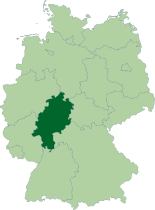 Hesse (/ˈhɛsə/) or Hessia (German: Hessen [ˈhɛsn̩], Hessian dialect: Hesse [ˈhɛzə]), officially the State of Hesse (German: Land Hessen), is a federal state (Land) of the Federal Republic of Germany, with just over six million inhabitants. The state capital is Wiesbaden; the largest city is Frankfurt am Main. Hesse (/ˈhɛsə/) or Hessia (German: Hessen [ˈhɛsn̩], Hessian dialect: Hesse [ˈhɛzə]), officially the State of Hesse (German: Land Hessen), is a federal state (Land) of the Federal Republic of Germany, with just over six million inhabitants. The state capital is Wiesbaden; the largest city is Frankfurt am Main.
As a cultural region, Hesse also includes the area known as Rhenish Hesse (Rheinhessen) in the neighbouring state of Rhineland-Palatinate.
The German name Hessen, like the name of other German regions (Schwaben “Swabia”, Franken “Franconia”, Bayern “Bavaria”, Sachsen “Saxony”) is derived from the dative plural form of the name of the inhabitants or eponymous tribe, the Hessians (Hessen, singular Hesse), short for the older compound name Hessenland (“land of the Hessians”). The Old High German form of the name is recorded as Hessun (dative plural of Hessi), in Middle Latin as Hassia, Hessia, Hassonia. The name of the Hessians ultimately continues the tribal name of the Chatti.[6] The ancient name Chatti by the 7th century is recorded as Chassi, and from the 8th century as Hassi or Hessi.
An inhabitant of Hesse is called a “Hessian” (German: Hesse (masculine) or Hessin (feminine), plural Hessen). The American English term Hessian for 18th-century British auxiliary troops originates with Landgrave Frederick II of Hesse-Cassel hiring out regular army units to the government of Great Britain to fight in the American Revolutionary War.
The English form Hesse is in common use by the 18th century, first in the hyphenated names Hesse-Cassel and Hesse-Darmstadt, but the latinate form Hessia remains in common English usage well into the 19th century. The German term Hessen is used by the European Commission even in English-language contexts because their policy is to leave regional names untranslated (paragraphs 1.31 and 1.35).
The synthetic element hassium, number 108 on the periodic table, was named after the state of Hesse in 1997, following a proposal of 1992.
The territory of Hesse was delineated only in 1945, as Greater Hesse, under American occupation. It corresponds only loosely to the medieval Landgraviate of Hesse. In the 19th century, prior to the unification of Germany, the territory of what is now Hesse comprised the territories of Grand Duchy of Hesse, the Duchy of Nassau, the free city of Frankfurt and the Electorate of Hesse (also known as Hesse-Cassel).
Early history
The Central Hessian region was inhabited in the Upper Paleolithic. Finds of tools in southern Hesse in Rüsselsheim suggest the presence of Pleistocene hunters about 13,000 years ago. A fossil hominid skull that was found in northern Hesse, just outside the village of Rhünda, has been dated at 12,000 years ago. The Züschen tomb (German: Steinkammergrab von Züschen, sometimes also Lohne-Züschen) is a prehistoric burial monument, located between Lohne and Züschen, near Fritzlar, Hesse, Germany. Classified as a gallery grave or a Hessian-Westphalian stone cist (hessisch-westfälische Steinkiste), it is one of the most important megalithic monuments in Central Europe. Dating to c. 3000 BC, it belongs to the Late Neolithic Wartberg culture.
An early Celtic presence in what is now Hesse is indicated by a mid-5th-century BC La Tène-style burial uncovered at Glauberg. The region was later settled by the Germanic Chatti tribe around the 1st century BC, and the name Hesse is a continuation of that tribal name.
The ancient Romans had a military camp in Dorlar, and in Waldgirmes directly on the eastern outskirts of Wetzlar was a civil settlement under construction. Presumably, the provincial government for the occupied territories of the right bank of Germania was planned at this location. The governor of Germania, at least temporarily, likely had resided here. The settlement appears to have been abandoned by the Romans after the devastating Battle of the Teutoburg Forest failed in the year AD 9. The Chatti were also involved in the Revolt of the Batavi in AD 69.
Hessia, from the early 7th century on, served as a buffer between areas dominated by the Saxons (to the north) and the Franks, who brought the area to the south under their control in the early sixth century and occupied Thuringia (to the east) in 531. Hessia occupies the northwestern part of the modern German state of Hesse; its borders were not clearly delineated. Its geographic center is Fritzlar; it extends in the southeast to Hersfeld on the Fulda River, in the north to past Kassel and up to the rivers Diemel and Weser. To the west, it occupies the valleys of the Rivers Eder and Lahn (the latter until it turns south). It measured roughly 90 kilometers north-south, and 80 north-west.
The area around Fritzlar shows evidence of significant pagan belief from the 1st century on. Geismar was a particular focus of such activity; it was continuously occupied from the Roman period on, with a settlement from the Roman period, which itself had a predecessor from the 5th century BC. Excavations have produced a horse burial and bronze artifacts. A possible religious cult may have centered on a natural spring in Geismar, called Heilgenbron; the name “Geismar” (possibly “energetic pool”) itself may be derived from that spring. The village of Maden, Gudensberg [de], now a part of Gudensberg near Fritzlar and less than ten miles from Geismar, was likely an ancient religious center; the basaltic outcrop of Gudensberg is named after Wodan, and a two-meter tall quartzite megalith called the Wotanstein is at the center of the village.
By the mid-7th century, the Franks had established themselves as overlords, which is suggested by archeological evidence of burials, and they built fortifications in various places, including Christenberg. By 690, they took direct control over Hessia, apparently to counteract expansion by the Saxons, who built fortifications in Gaulskopf and Eresburg across the River Diemel, the northern boundary of Hessia. The Büraburg (which already had a Frankish settlement in the sixth century) was one of the places the Franks fortified to resist the Saxon pressure, and according to John-Henry Clay, the Büraburg was “probably the largest man-made construction seen in Hessia for at least seven hundred years”. Walls and trenches totaling one kilometer in length were made, and they enclosed “8 hectares of a spur that offered a commanding view over Fritzlar and the densely-populated heart of Hessia”.
Following Saxon incursions into Chattish territory in the 7th century, two gaue had been established; a Frankish one, comprising an area around Fritzlar and Kassel, and a Saxonian one. In the 9th century, the Saxon Hessengau also came under the rule of the Franconians.
Holy Roman Empire
Hessengau was passed to Thuringia. In the War of the Thuringian  Succession (1247-1264), Hesse gained independence and became a Landgraviate within the Holy Roman Empire. It shortly rose to primary importance under Landgrave Philip the Magnanimous, who was one of the leaders of German Protestantism. After Philip’s death in 1567, the territory was divided among his four sons from his first marriage (Philip was a bigamist) into four lines: Hesse-Kassel (or Hesse-Cassel), Hesse-Darmstadt, Hesse-Rheinfels, and the also previously existing Hesse-Marburg. As the latter two lines died out quite soon (1583 and 1605, respectively), Hesse-Kassel and Hesse-Darmstadt were the two core states within the Hessian lands. Several collateral lines split off during the centuries, such as in 1622, when Hesse-Homburg split off from Hesse-Darmstadt. In the late 16th century, Kassel adopted Calvinism, while Darmstadt remained Lutheran and subsequently the two lines often found themselves on different sides of a conflict, most notably in the disputes over Hesse-Marburg and in the Thirty Years’ War, when Darmstadt fought on the side of the Emperor, while Kassel sided with Sweden and France. Succession (1247-1264), Hesse gained independence and became a Landgraviate within the Holy Roman Empire. It shortly rose to primary importance under Landgrave Philip the Magnanimous, who was one of the leaders of German Protestantism. After Philip’s death in 1567, the territory was divided among his four sons from his first marriage (Philip was a bigamist) into four lines: Hesse-Kassel (or Hesse-Cassel), Hesse-Darmstadt, Hesse-Rheinfels, and the also previously existing Hesse-Marburg. As the latter two lines died out quite soon (1583 and 1605, respectively), Hesse-Kassel and Hesse-Darmstadt were the two core states within the Hessian lands. Several collateral lines split off during the centuries, such as in 1622, when Hesse-Homburg split off from Hesse-Darmstadt. In the late 16th century, Kassel adopted Calvinism, while Darmstadt remained Lutheran and subsequently the two lines often found themselves on different sides of a conflict, most notably in the disputes over Hesse-Marburg and in the Thirty Years’ War, when Darmstadt fought on the side of the Emperor, while Kassel sided with Sweden and France.
The Landgrave Frederick II (1720-1785) ruled as a benevolent despot, from 1760 to 1785. He combined Enlightenment ideas with Christian values, cameralist plans for central control of the economy, and a militaristic approach toward diplomacy. He funded the depleted treasury of the poor nation by loaning 19,000 soldiers in complete military formations to Great Britain to fight in North America during the American Revolutionary War, 1776-1783. These soldiers, commonly known as Hessians, fought under the British flag. The British used the Hessians in several conflicts, including in the Irish Rebellion of 1798. For further revenue, the soldiers were loaned to other places as well. Most were conscripted, with their pay going to the Landgrave. from 1760 to 1785. He combined Enlightenment ideas with Christian values, cameralist plans for central control of the economy, and a militaristic approach toward diplomacy. He funded the depleted treasury of the poor nation by loaning 19,000 soldiers in complete military formations to Great Britain to fight in North America during the American Revolutionary War, 1776-1783. These soldiers, commonly known as Hessians, fought under the British flag. The British used the Hessians in several conflicts, including in the Irish Rebellion of 1798. For further revenue, the soldiers were loaned to other places as well. Most were conscripted, with their pay going to the Landgrave.
 Germany, officially the Federal Republic of Germany, officially the Federal Republic of  Germany is a federal parliamentary republic in western-central Europe. It includes 16 constituent states and covers an area of 357,021 square kilometres (137,847 sq mi) with a largely temperate seasonal climate. Its capital and largest city is Berlin. With 81 million inhabitants, Germany is the most populous member state in the European Union. After the United States, it is the second most popular migration destination in the world. Germany is a federal parliamentary republic in western-central Europe. It includes 16 constituent states and covers an area of 357,021 square kilometres (137,847 sq mi) with a largely temperate seasonal climate. Its capital and largest city is Berlin. With 81 million inhabitants, Germany is the most populous member state in the European Union. After the United States, it is the second most popular migration destination in the world.
Various Germanic tribes have occupied northern Germany since classical antiquity. A region named Germania was documented before 100 CE. During the Migration Period the Germanic tribes expanded southward. Beginning in the 10th century, German territories formed a central part of the Holy Roman Empire. During the 16th century, northern German regions became the centre of the Protestant Reformation.
The rise of Pan-Germanism inside the German Confederation resulted in the unification of most of the German states in 1871 into the Prussian-dominated German Empire. After World War I and the German Revolution of 1918-1919, the Empire was replaced by the parliamentary Weimar Republic. The establishment of the Third Reich in 1933 led to World War II and the Holocaust. After 1945, Germany split into two states, East Germany and West Germany. In 1990, the country was reunified.
 In the 21st century, Germany is a great power and has the world’s fourth-largest economy by nominal GDP, as well as the fifth-largest by PPP. As a global leader in several industrial and technological sectors, it is both the world’s third-largest exporter and importer of goods. Germany is a developed country with a very high standard of living sustained by a skilled and productive society. It upholds a social security and universal health care system, environmental protection and a tuition free university education. In the 21st century, Germany is a great power and has the world’s fourth-largest economy by nominal GDP, as well as the fifth-largest by PPP. As a global leader in several industrial and technological sectors, it is both the world’s third-largest exporter and importer of goods. Germany is a developed country with a very high standard of living sustained by a skilled and productive society. It upholds a social security and universal health care system, environmental protection and a tuition free university education.
Germany was a founding member of the European Union in 1993. It is part of the Schengen Area, and became a co-founder of the Eurozone in 1999. Germany is a member of the United Nations, NATO, the G8, the G20, and the OECD. The national military expenditure is the 9th highest in the world. Known for its rich cultural history, Germany has been continuously the home of influential artists, philosophers, musicians, sportsmen, entrepreneurs, scientists and inventors.
|





 Ernest Louis (German: Ernst Ludwig Karl Albrecht Wilhelm; 25 November 1868 – 9 October 1937) was the last Grand Duke of Hesse and by Rhine, reigning from 1892 until 1918.
Ernest Louis (German: Ernst Ludwig Karl Albrecht Wilhelm; 25 November 1868 – 9 October 1937) was the last Grand Duke of Hesse and by Rhine, reigning from 1892 until 1918. Hesse (/ˈhɛsə/) or Hessia (German: Hessen [ˈhɛsn̩], Hessian dialect: Hesse [ˈhɛzə]), officially the State of Hesse (German: Land Hessen), is a federal state (Land) of the Federal Republic of Germany, with just over six million inhabitants. The state capital is Wiesbaden; the largest city is Frankfurt am Main.
Hesse (/ˈhɛsə/) or Hessia (German: Hessen [ˈhɛsn̩], Hessian dialect: Hesse [ˈhɛzə]), officially the State of Hesse (German: Land Hessen), is a federal state (Land) of the Federal Republic of Germany, with just over six million inhabitants. The state capital is Wiesbaden; the largest city is Frankfurt am Main.  Succession (1247-1264), Hesse gained independence and became a Landgraviate within the Holy Roman Empire. It shortly rose to primary importance under Landgrave Philip the Magnanimous, who was one of the leaders of German Protestantism. After Philip’s death in 1567, the territory was divided among his four sons from his first marriage (Philip was a bigamist) into four lines: Hesse-Kassel (or Hesse-Cassel), Hesse-Darmstadt, Hesse-Rheinfels, and the also previously existing Hesse-Marburg. As the latter two lines died out quite soon (1583 and 1605, respectively), Hesse-Kassel and Hesse-Darmstadt were the two core states within the Hessian lands. Several collateral lines split off during the centuries, such as in 1622, when Hesse-Homburg split off from Hesse-Darmstadt. In the late 16th century, Kassel adopted Calvinism, while Darmstadt remained Lutheran and subsequently the two lines often found themselves on different sides of a conflict, most notably in the disputes over Hesse-Marburg and in the Thirty Years’ War, when Darmstadt fought on the side of the Emperor, while Kassel sided with Sweden and France.
Succession (1247-1264), Hesse gained independence and became a Landgraviate within the Holy Roman Empire. It shortly rose to primary importance under Landgrave Philip the Magnanimous, who was one of the leaders of German Protestantism. After Philip’s death in 1567, the territory was divided among his four sons from his first marriage (Philip was a bigamist) into four lines: Hesse-Kassel (or Hesse-Cassel), Hesse-Darmstadt, Hesse-Rheinfels, and the also previously existing Hesse-Marburg. As the latter two lines died out quite soon (1583 and 1605, respectively), Hesse-Kassel and Hesse-Darmstadt were the two core states within the Hessian lands. Several collateral lines split off during the centuries, such as in 1622, when Hesse-Homburg split off from Hesse-Darmstadt. In the late 16th century, Kassel adopted Calvinism, while Darmstadt remained Lutheran and subsequently the two lines often found themselves on different sides of a conflict, most notably in the disputes over Hesse-Marburg and in the Thirty Years’ War, when Darmstadt fought on the side of the Emperor, while Kassel sided with Sweden and France.  from 1760 to 1785. He combined Enlightenment ideas with Christian values, cameralist plans for central control of the economy, and a militaristic approach toward diplomacy. He funded the depleted treasury of the poor nation by loaning 19,000 soldiers in complete military formations to Great Britain to fight in North America during the American Revolutionary War, 1776-1783. These soldiers, commonly known as Hessians, fought under the British flag. The British used the Hessians in several conflicts, including in the Irish Rebellion of 1798. For further revenue, the soldiers were loaned to other places as well. Most were conscripted, with their pay going to the Landgrave.
from 1760 to 1785. He combined Enlightenment ideas with Christian values, cameralist plans for central control of the economy, and a militaristic approach toward diplomacy. He funded the depleted treasury of the poor nation by loaning 19,000 soldiers in complete military formations to Great Britain to fight in North America during the American Revolutionary War, 1776-1783. These soldiers, commonly known as Hessians, fought under the British flag. The British used the Hessians in several conflicts, including in the Irish Rebellion of 1798. For further revenue, the soldiers were loaned to other places as well. Most were conscripted, with their pay going to the Landgrave.  Germany, officially the Federal Republic of
Germany, officially the Federal Republic of  Germany is a federal parliamentary republic in western-central Europe. It includes 16 constituent states and covers an area of 357,021 square kilometres (137,847 sq mi) with a largely temperate seasonal climate. Its capital and largest city is Berlin. With 81 million inhabitants, Germany is the most populous member state in the European Union. After the United States, it is the second most popular migration destination in the world.
Germany is a federal parliamentary republic in western-central Europe. It includes 16 constituent states and covers an area of 357,021 square kilometres (137,847 sq mi) with a largely temperate seasonal climate. Its capital and largest city is Berlin. With 81 million inhabitants, Germany is the most populous member state in the European Union. After the United States, it is the second most popular migration destination in the world. In the 21st century, Germany is a great power and has the world’s fourth-largest economy by nominal GDP, as well as the fifth-largest by PPP. As a global leader in several industrial and technological sectors, it is both the world’s third-largest exporter and importer of goods. Germany is a developed country with a very high standard of living sustained by a skilled and productive society. It upholds a social security and universal health care system, environmental protection and a tuition free university education.
In the 21st century, Germany is a great power and has the world’s fourth-largest economy by nominal GDP, as well as the fifth-largest by PPP. As a global leader in several industrial and technological sectors, it is both the world’s third-largest exporter and importer of goods. Germany is a developed country with a very high standard of living sustained by a skilled and productive society. It upholds a social security and universal health care system, environmental protection and a tuition free university education.

